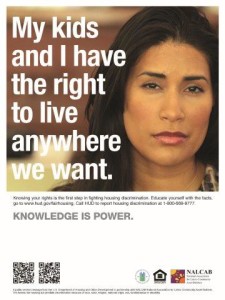Amid all the overarching attention to housing segregation and inclusiveness prompted by HUD’s newly released AFFH rule, we shouldn’t lose sight of housing discrimination at the granular, or individual level. It’s still very much with us, in Vermont and everywhere else. What’s more, there’s a good deal of housing discrimination that goes unreported, as a cursory look at Vermont’s statistics makes clear.
First, the national picture: HUD does an annual report toting up housing discrimination complaints based on seven protected categories in the Fair Housing Act: race, color, national origin, religion, sex, disability, familial status. In the last fiscal year for which data are available, total complaints to HUD and affiliated agencies totaled 8,368, of which 53 percent were based on disability, 28 percent on race, 14 percent on familial status (presence of minor children) and 12 percent on national origin.
Now consider the complaints filed with the Vermont Human Rights Commission. According to the commission’s most recent annual report, there were 41 housing discrimination complaints in Fiscal Year 2014, of which 19 were based on disability, 4 on race/color, 4 on “minor children,” and 1 on national origin.
The numbers in Vermont are pretty low, and the discriminatory profile is a bit different from the that for the nation as a whole. Disability is the major source of complaints here, as elsewhere, but in Vermont just 10 percent of the complaints pertained to race. Granted, Vermont is 95 percent white, but the number seems low for two reasons.
For one thing, hundreds of refugees are arriving in Vermont every year. It seems implausible that they confront no discrimination based in the real-estate rental market based on race, religion or national origin.
For another thing, Vermont Legal Aid’s periodic tests of Vermont’s rental markets show much higher incidences of discrimination than are reflected in the complaint statistics.
In 2012-13, VLA conducted more than 200 tests, using control testers and subject testers of assorted races and national origins expressing interest in renting apartments. “Forty-four percent of the tests conducted either demonstrated overt discrimination against the subject tester or otherwise showed preferential treatment toward the control tester,” the VLA’s report concluded. “(T)here were significant rates of disparate treatment against the subject testers in 46 percent of the national origin tests, 45 percent of the familial status test, 36 percent of the African American race/color tests, and 22 percent of the disability tests.”
So, why aren’t more fair housing complaints filed in Vermont? Perhaps because many tenants don’t know their rights, or because they might fear retaliation. As it happens, protection from retaliation is one the rights they might not be aware of.
